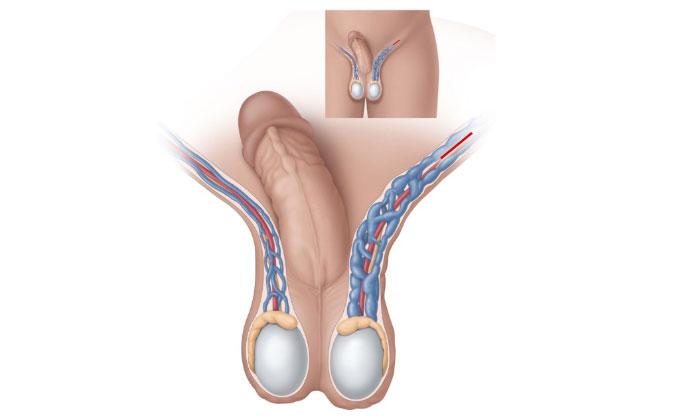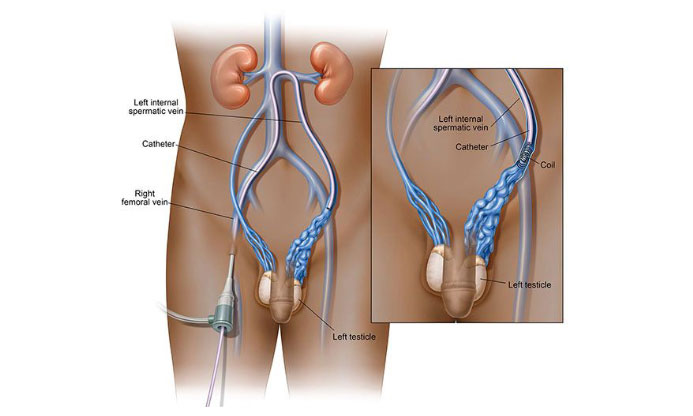Table of contents
WHAT IS VARICOCELE?
A varicocele is an enlargement of the veins within the loose bag of skin that holds your testicles (the scrotum). Varicoceles are similar to varicose veins in the leg.
Varicoceles are uncommon in boys younger than age 10, they occur usually in prepubescent and adolescent boys and rarely develop after adolescence. Most varicoceles are found only on the left side because of the way blood drains from the left testicle. In some cases, they can also develop above the right or in both testicles.

Varicoceles are usually found in the left side of the scrotum.
SYMPTOMS
Varicoceles usually have no symptoms, are not painful, do not usually cause any serious problems, and do not need treatment. You may notice a varicocele, or it may be noticed by your parents or by a doctor during a routine physical examination or during a fertility evaluation at an older age.
Treatment might be advised if a varicocele:
- Is painful
- Causes a testicle to under develop or shrink (testicular hypotrophy)
- Affects the ability to father children (fertility)
Pain is rare, and when present:
- Vary from sharp to dull discomfort in the scrotum
- Increase with standing or physical exertion
- Worsen over the course of the day
- Be relieved when you lie on your back.
Shrinkage of the affected testicle (atrophy): most of the testicle is made up of sperm-producing tubules. When they are damaged, as from a varicocele, the testicle shrinks and softens. It is not clear what causes the testicle to shrink, but the malfunctioning valves allow blood to pool in the veins. This pooling can result in increased pressure in the veins that may cause testicular damage.
Varicoceles can affect fertility by reducing blood flow and raising the temperature of the testicles. This can affect sperm formation, movement (motility), and function, so the testicles produce fewer sperm, and the sperm that is produced might not be healthy. Early treatment can help produce healthier sperm and even regrowth of a testicle.
HOW IS THE DIAGNOSIS MADE?
It is usually relatively simple to diagnose a varicocele. Your doctor will take a detailed medical history and ask questions about your symptoms, if any.
- Examination by a doctor is crucial to rule out or confirm a varicocele. Your doctor will carefully examine your external genitals. A collection of swollen and tangled veins in the scrotum that can be felt more in the upright posture or during straining, suggests a varicocele. The swollen veins may feel like a “bag of worms”. Both testicles should be examined to compare their size. The testicle affected by varicocele is usually smaller.
- Ultrasound exam. Backward flow of blood in the swollen testicular veins is usually confirmed by ultrasound of the scrotum.
A right-side-only varicocele is uncommon. In extremely rare cases, it might be caused by a tumour of the kidney. Ultrasound of the kidneys should be performed to rule it out.
CLASSIFICATION AND CAUSE
It is not known why varicoceles develop. They are caused when the one-way valves in the scrotal veins, which allow blood to flow from the testicles and scrotum back to the heart against gravity, become dysfunctional. The resulting backup causes the veins to widen (dilate) to form a varicocele.
The severity of a varicocele can be classified into three grades:
- Can be felt by hand only during straining (grade I)
- Can be felt by hand when relaxed (grade II)
- Can become clearly visible at a distance, even at complete rest (grade III)
TREATMENT
Varicoceles can be treated either by surgery or embolization, however often there is no indication for treatment.
Clear indications to repair a varicocele in adolescence include progressive testicular atrophy, pain, marked swelling or physical discomfort, abnormal semen analysis results.
If none of these criteria apply to you, surgery is not needed. You should visit your doctor annually until sperm can be analysed.
SURGERY
The surgical procedure blocks the enlarged veins from draining blood from the testicle. This blockage redirects the blood flow to healthy veins. This can be done:
- Through a small cut in the groin with the use of surgical microscope
- Though multiple small cuts made with laparoscopic instruments.
During surgery, your doctor will try to protect nearby structures called lymphatic vessels. These tiny structures are usually invisible to the naked eye. They carry lymph, a clear, yellowish liquid that collects in all parts of the body. If they are injured, lymph cannot flow properly, and complications can develop. This surgery, called lymphatic-sparing varicocelectomy, lowers the chance of complications.
What are the most common complications after surgery?
- Collection of fluid in the scrotum around the testicle (hydrocele formation).
- Shrinking of the testicle (testicular hypotrophy).
- Reduced function of the testicle.
- Rarely, injury to the testicular artery.

Blockage (cutting) of the enlarged veins.
ANGIOGRAPHIC OCCLUSION
Angiographic occlusion or embolization is a good alternative to surgery to treat varicocele. It is performed by either a vascular surgeon or an interventional radiologist. Injection of contrast through a tube with X-ray guidance is used to see the source of the problem. The goal is to find all veins leading to the varicocele. Coils, plugs with or without sclerosant, are used to block the blood flow to the varicocele and scar them down. It is done either with local anaesthetic or with light sedation through a very small hole in the groin or neck. The method most often lasts 45 minutes to an hour.

Angiographic embolization
AFTER SURGERY OR EMBOLIZATION
You may be able to return to normal, non-strenuous activities after 2 days. As long as you are not uncomfortable, you may return to more strenuous activity, such as exercising, after 2–4 weeks in case of surgery, 7-10 days in case of embolization.
Pain from this surgery is usually mild but may continue for several days or weeks. Your doctor may prescribe pain medication for a limited time after surgery. Wearing briefs or a jockstrap can also help by relieving pressure in the testicles.
It will take several months after surgery before improvements in sperm quality can be seen with a semen analysis. This is because it takes approximately 3 to 4 months for new sperm to develop.
FREQUENTLY ASKED QUESTIONS
What will happen if I choose not to be treated?
Majority of males with varicocele will not have problems. One out of 5 males with varicocele will experience difficulty fathering children. Semen analysis is highly recommended after age 16 years to determine if varicocele repair is needed. If a semen analysis is normal it is recommended to have a repeat analysis every 2 to 3 years as with time the quality of sperms may decrease. Fertility issues may come up years later, even if not seen earlier.
My teenage son was diagnosed with a varicocele. Should this be fixed?
Treatment of teens depends on each case. It’s of great value to talk about choices with an urologist or paediatric urologist. Varicocele repair in a teen may be a good choice if there is pain, if one testicle is much smaller than the other, or the teen has an abnormal semen analysis performed at age 16 years. Some choose repair so they won’t have to worry about fertility issues in the future. Semen analyses can be done in older teens to see if repair would help.
I have no symptoms, but wish to have children. Should I have my varicocele repaired?
As a rule, varicoceles with no symptoms are not repaired. Most urologists do not believe these varicoceles cause health problems if not treated. If there’s worry about fertility, semen analysis can be done to see if the varicocele is harming sperm quality.
I have pain with my varicocele. What can I do to ease the pain?
Supporting the scrotum with a jockstrap or briefs-style underwear can help varicocele pain. Lying on your back helps the varicocele drain, and often eases pain. Taking pain killers (such as acetaminophen and ibuprofen) may also help. You can also talk with your urologist about varicocele repair.
I am thinking about having my varicocele repaired for fertility reasons. How long will I have to wait to see if my semen quality improves?
Semen analyses are often done 3 to 4 months after the procedure. Semen quality often improves within 6 months, but it may also take as long as a year.
I found a lump on my scrotum during a self-exam. Should I worry?
Abnormalities in the male reproductive tract may show up as a mass in the scrotum. Masses could be nothing to worry about and may have little effect on your health. Or they could be a sign of life-threatening illness. It’s of great value to find out what is causing your mass. One type of mass may be testicular cancer. This would be cause for concern and calls for quick action. It’s vital to see a doctor when you find any lump or bump in your testicle.



